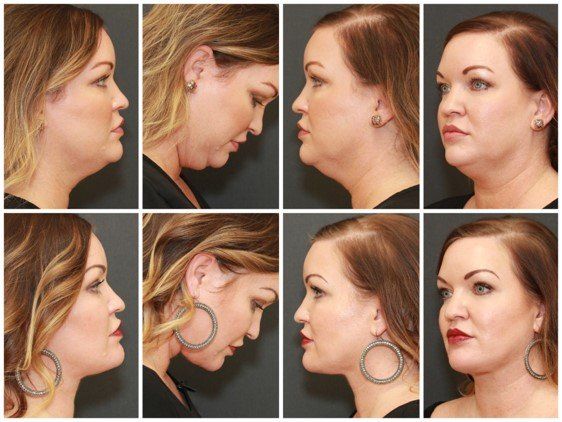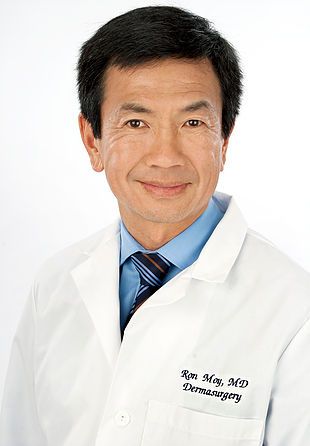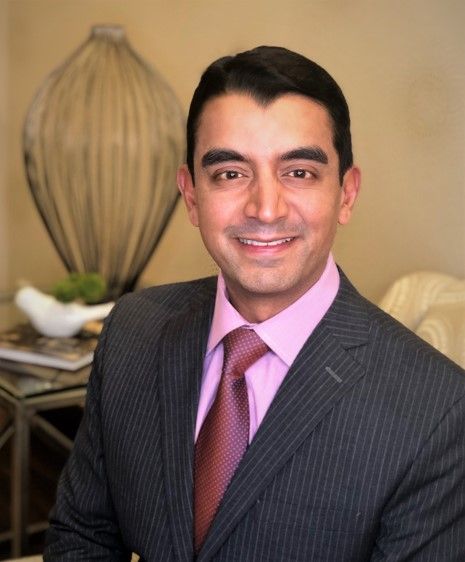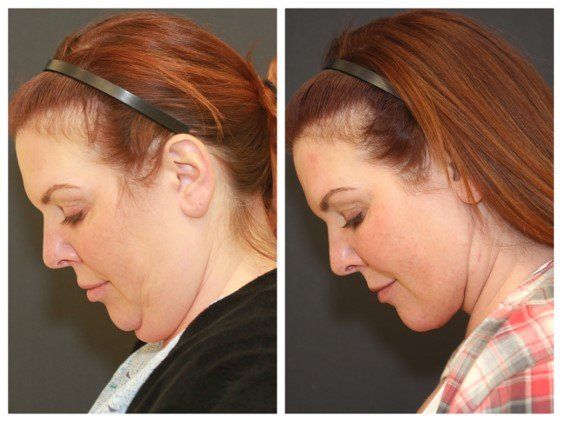- Case-Based Roundtable
- General Dermatology
- Eczema
- Chronic Hand Eczema
- Alopecia
- Aesthetics
- Vitiligo
- COVID-19
- Actinic Keratosis
- Precision Medicine and Biologics
- Rare Disease
- Wound Care
- Rosacea
- Psoriasis
- Psoriatic Arthritis
- Atopic Dermatitis
- Melasma
- NP and PA
- Skin Cancer
- Hidradenitis Suppurativa
- Drug Watch
- Pigmentary Disorders
- Acne
- Pediatric Dermatology
- Practice Management
- Prurigo Nodularis
- Buy-and-Bill
Publication
Article
Dermatology Times
There’s more than one way to rejuvenate the neck
Author(s):
Minimally invasive treatments can help to make an older neck look younger, but it’s usually not enough, say two experts who share their favorite approaches.
Photo courtesy Mike Nayak, M.D.

Dr. Moy

Dr. Nayak

Patient shown before and after neck lift. Photo courtesy Ronald Moy, M.D.

Patient shown before and after deep neck lift. No skin was removed, or any incisions made around the ears. The entire procedure was performed through one incision under the chin. Photo courtesy Mike Nayak, M.D.

Patient shown before and after deep neck lift. No skin was removed, or any incisions made around the ears. The entire procedure was performed through one incision under the chin. Photo courtesy Mike Nayak, M.D.

Age takes a toll on the neck. And while minimally invasive treatments might help to make an older neck look a tad younger, it’s usually not enough, according to Beverly Hills, Calif., dermatologist Ronald Moy, M.D.
“A simple neck lift without a facelift works really well,” says Dr. Moy, past president of the American Academy of Dermatology, American Society for Dermatologic Surgery and American Board of Facial Cosmetic Surgery. “It always looks natural, yet it still improves the lower face. It sort of gives you a lower facelift.”
Surgeons can perform a neck lift restricted to the area behind the ear under local anesthesia. The procedure is relatively short - about an hour and a half. Thanks to tumescent anesthesia, there’s little risk of bleeding. And it usually addresses patients’ biggest concerns, according to Dr. Moy.
“Generally, it’s the pullback posteriorly - the backward pull - that really does all the tightening. That usually tightens the platysma muscle and tightens the skin,” he says. “We usually don’t have to make the incision in the submental area, where you’d have to suture the bands together or do some type of suctioning. The posterior pull really does all of that.”
Whether he’s operating on men’s or women’s necks, Dr. Moy says he usually removes about 2 inches of skin.
“Technically it’s simple - it’s just trimming and suturing. Any dermatologist can do that procedure. And patients are really happy with the results,” he says.
The simple neck lift is relatively complication-free, but it’s important for dermatologists and others to educate patients about what they can expect.
“When you’re pulling from behind the ear and the patient leans forward a little bit, the patient still might have some looseness. I think it’s important to educate patients that they’re going to get an improved neck, but it’s not going to get rid of all the looseness,” he says.
A less invasive approach using a radiofrequency heating device to tighten neck skin or to help prevent the skin from getting too loose remains an option for some patients in their 40s - even early 50s, according to Dr. Moy.
“Bioidentical hormones can decrease some of the sagging under the neck, or some of the creams like epidermal growth factor. These and radiofrequency device treatments, however, are not for someone who has [more significant] sagging,” Dr. Moy says. “Generally, when you get patients into their late 50s, you’re most likely going to be doing the neck lift.”
The Deep Neck Lift
St. Louis, Mo., facial plastic surgeon Mike Nayak, M.D., goes to greater lengths to restore a youthful look to the neck. He says his approach, the deep neck lift, bucks conventional surgical neck lifting thinking.
Traditionally, aesthetic surgeons approach neck lifts by suctioning subcutaneous fat, tightening the platysma area, then pulling skin from the sides to create a “tighter hammock,” he says.
“The reality is that the neck is built in layers and by treating just the first few layers of skin and subcutaneous fat, there is a finite amount of change you can make,” Dr. Nayak says. “You also can get a really off-looking result by overtreating those first couple of layers and then leaving the deeper layers alone. You can get a very disjointed look that’s not pretty, but it is tight-looking.”
Dr. Nayak says in recent years he has been safely modifying all the layers of the neck. He rebuilds the neck’s deeper layers to the shape and form of not just the younger neck but a genetically gifted younger neck, he says.
“Some people even when they’re 20 don’t have a great shape to their neck because they were born with the genetics for a more oblique or obtuse neck,” Dr. Nayak says. “I actually also use these techniques in younger people in their 20s and 30s.”
Specifically, those layers are the digastric, mylohyoid, geniohyoid and deeper muscles of the neck. Dr. Nayak says he also reshapes overgrown or mal-positioned submandibular salivary glands. He then sets the platysma muscle and skin snuggly - not tightly - over the new foundation, so the neck has no choice but to follow that new shape.
He treats the subcutaneous fat in the neck conservatively because most aging necks don’t have excess fat.
“You want to leave as much of that as possible to get a soft, natural looking result, as opposed to a skeletonized ancient-looking result,” Dr. Nayak says.
As for skin, Dr. Nayak says he removes way less than one might imagine.
“The new angled contour is like two legs of a triangle. It actually is a longer path for the skin to follow new, angular contour,” he says. “In many of my patients I don’t take any skin. Because we require all of that skin to line the new concave shape.”
So, what has changed as a result of this surgery? According to Dr. Nayak who has done about 500 deep neck lift procedures: Everything.
But the procedure is complex and requires a significant learning curve. Dr. Nayak says most surgeons think it’s too much of a procedure to learn and offer their patients.
Treating the first few layers of skin and subcutaneous fat is generally safe.
“The worst thing that could happen with a superficial, traditional neck lift is you get bleeding that needs to be drained or you could injure the skin and get scarring, but that’s pretty uncommon,” he says. “When you start going to the deeper layers of the neck, now you’re near the vital structures. There are much more significant blood vessels. There are the nerves that allow you to move your lips. There are the nerves that allow you to move your tongue; nerves that give you feeling in the tongue and feeling in the lips. The key to that kind of surgery is you have to have an excellent understanding of the layered anatomy of the neck and head and neck surgery techniques. You need great assistants, great light, great equipment and an unhurried day in the operating room.”
The deep neck lift takes two or three times longer than most cosmetic procedures for the neck.
But if a patient wants dramatic results, there are really no shortcuts, he says.
Nonsurgical Neck Treatments
Dr. Nayak says nonsurgical treatments have a role in some aspects of neck rejuvenation. He agrees with Dr. Moy that the role is limited.
Fractional laser resurfacing, some kinds of high frequency ultrasound and sometimes radiofrequency can modestly tighten the skin layer. There are some treatments that can modestly thin the subcutaneous fat layer, such as CoolSculpting (Allergan) and Kybella (Allergan), he says.
“In young, fluffy baby fat faces, thinning the fat can actually be helpful. The irony with Kybella and CoolSculpting and sometimes radiofrequency energy is, the patients that are best suited for them are the younger ones with fluffy baby fat in the neck. They often have the hardest time affording $3000, $4000, $5000 worth of repeat nonsurgical treatments. They often end up being a better liposuction candidate, where we liposuction their necks in one setting for $2000,” Dr. Nayak says.
High-frequency ultrasound can modestly tighten the platysma area, he says.
“There is still a role for nonsurgical treatments, but those nonsurgical treatments would usually require some sort of a combination approach to treat the individual layers that they are best at treating. It usually requires a budget that by the time you’ve treated those layers and treated them well, it pretty much approaches a surgical budget,” Dr. Nayak says. “Still, you’re left treating those first few layers a little bit unpredictably and incompletely, and completely ignoring the deeper layers.”
The solution, Dr. Nayak says, is to work from what patients want as far as outcomes and decide from there on options that will best suit their lifestyles and budgets.






